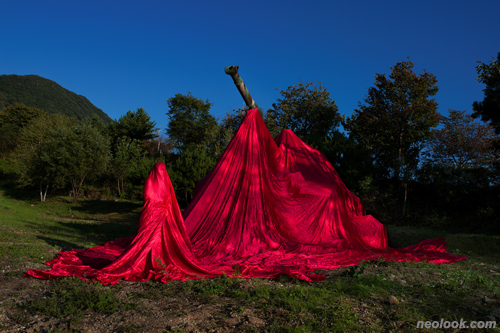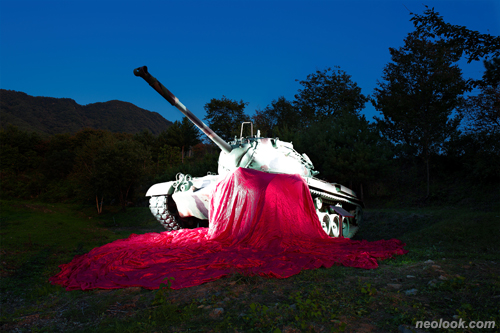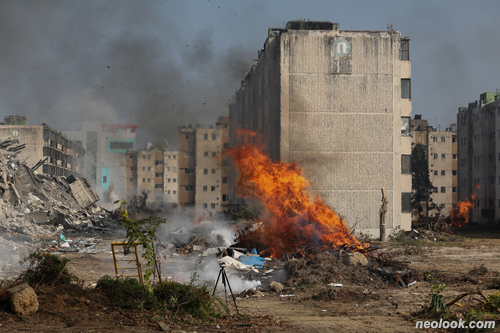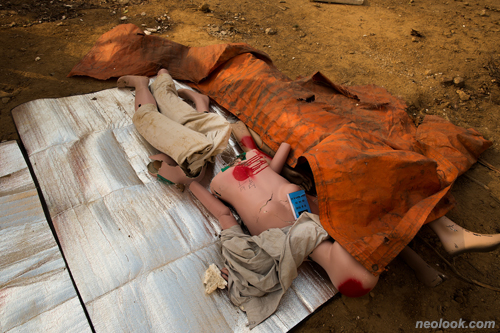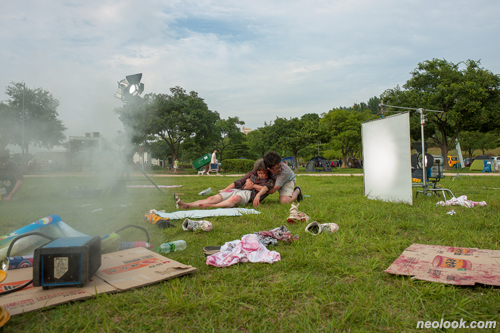- ● homepage
- ● archives
- ● restoration
- ● books
- ● big banners
- ● post board
- ■ neo's search
- ■ about us
- ■ 게재방법 안내
- 개인정보처리방침

- [email protected]
- Tel. 02_335_7922
- Fax. 02_335_7929
- 10:00am~04:30pm
- 월요일~금요일
- 3/3(월) 대체공휴일

불안 ON/OFF / Anxiety ON/OFF
임안나展 / LIMANNA / 林安羅 / photography 2020_1111 ▶ 2021_0131 / 월,공휴일 휴관
● 위 이미지를 클릭하면 네오룩 아카이브 Vol.20190426b | 임안나展으로 갑니다.
별도의 초대일시가 없습니다.
후원 / 일우재단
관람시간 화~금_10:00am~06:30pm / 토_01:00pm~06:30pm 일_01:30pm~06:30pm / 월,공휴일 휴관
일우 스페이스 ILWOO SPACE 서울 중구 서소문로 117 대한항공빌딩 1층 Tel. +82.(0)2.753.6502 www.ilwoo.org
'불안'의 재연 불가능성에 대한 재현 ● 재난이 일상이 된 시대를 살고 있다. 2001년 9.11 테러 이후 십 여 년 간 지속된 이라크 전쟁과 유럽 전역의 무차별 테러로 전세계 사람들은 전쟁과 테러의 참상을 미디어에서 일상적으로 접하고 그로 인한 공포와 불안으로부터 자유로울 수 없게 되었다. 뿐만 아니라 환경오염과 지구온난화가 지구 곳곳에서 자연재해를 일으키고 정확한 원인을 알 수 없는 변종 바이러스가 감염병의 위협을 초래하는 가운데, 마침내 지구는 '코로나바이러스(COVID-19)'의 팬데믹 상황을 맞이하였다. 오늘날 신자유주의 시대 전 세계 사람들은 자본의 생산과 소비뿐 아니라 감염병마저 공통의 현상으로 마주하게 된 것이다. 한국은 이에 더해 근현대사의 특수성으로 사회 안에 또 다른 재난의 공포와 불안이 만연하다. 한국전쟁 이후 급속한 산업화로 인해 부실공사, 안전관리 소홀, 사고의 늑장대처 등의 부작용이 수많은 사건사고로 이어져왔기 때문이다. 1990년대 중엽 몇 달 사이에 한강의 다리가 무너지고 도심의 백화점이 붕괴되었으며 지하철 건설현장에서 가스가 폭발하는 사고로 대규모의 사상자를 냈으며, 여객선이 침몰해 수백 명이 사망한 것이 불과 몇 년 전 일이다. ● 사진가 임안나는 누구나 언제든 재난의 당사자가 될지 모른다는 우리 사회에 잠재된 불안에 대해 말한다. 「불안의 리허설(Rehearsal of Anxiety)」(2016-2018)은 서울 도심에서 일어난 원인 모를 대참사의 현장을 찍은 사진 연작이다. 쉽게 알아차릴 수 있듯 사진 속 장면은 실제가 아닌 연출된 것이며 사람들 역시 특정 상황을 가정해 연기를 하고 있다. 시청 앞 광장, 광화문, 서울역 광장, 건물 붕괴 현장 등 서울 도심을 배경으로 100여 명의 지원자들이 참여하였으며 분장, 소품, 조명 등 영화 각 분야의 전문 스태프들을 도움을 받아 촬영되었다. 작가는 프로젝트 참여자들에게 뜻밖의 재난으로 마지막 순간을 맞이하거나 최후의 목격자가 되는 상황을 설명한 뒤 각자의 심리 상태를 연기할 것을 주문하였고, 참여자들은 각자 처한 구체적 처지를 설정하여 공포와 불안의 감정을 연기하였다. 사랑하는 사람과 마지막 순간을 함께하는 연인, 죽어가는 어머니를 구하고 최후를 맞이하는 아들, 아버지의 죽음 앞에 목 놓아 우는 아이, 최후의 순간까지 사건을 카메라에 담고 죽어가는 사진가 등 처한 상황은 각기 다르다.
흥미로운 것은 모두 다른 인물임에도 사진에서 크게 다르지 않은 전형적인 자세와 표정이 발견된다는 사실이다. 저마다 상처의 부위와 출혈의 정도가 다르지만 눈을 감거나 넋이 나간 듯 무표정하게 허공을 응시하는 표정은 물론, 약자를 구하고 보호하려 하거나 상대에 기대고 의지하려는 자세가 사진마다 크게 다르지 않다. 이들 머릿속에 각인된 재난과 비극의 상황 자체가 대부분 기존의 재현된 이미지에서 영향을 받은 것이고 그로 인해 현재의 감정 역시 어디까지나 '리허설'에 불과하기 때문일 것이다. 이는 고통을 재현하는 사진의 전형성을 보여준다. 예컨대 피 흘리며 쓰러진 여성을 양 팔에 안고 서 있는 남성의 사진에서 우리는 어렵지 않게 피에타 상을 떠올리게 된다. 연출된 사진이 아니라 하더라도 비극을 다루는 기록사진에서 특정 도상은 반복적으로 재현되어 왔다. 신화와 성경의 수많은 이야기를 그린 종교화부터 18-19세기 역사화에 이르기까지 고통 받는 육체를 그리는 관습은 유서 깊은 전통이며, 특정한 사건의 증거가 된다고 믿어 온 사진 역시 이러한 도상의 전통을 따르거나 적어도 사진의 역사 내에서 사람들의 시선을 잡아 끌만한 드라마틱한 장면을 포착하고자 '현실'이 아니지만 '현실적인' 일종의 전형을 만들어온 것이다. "사진은 사진을 흉내 내기 마련이다"는 말은 오늘날의 모든 사진에 해당한다. ● 임안나는 이러한 사실을 사진 속에서 그대로 드러낸다. 사람들의 표정이나 자세를 그럴듯하게 고치지 않을뿐더러 일부 사진에서는 조명과 설비를 화면 안에 드러냄으로써 해당 장면이 연출된 것임을 오히려 강조한다. 이는 모든 사진이 결코 실재 그 자체가 아니며, 사진 안에서의 논리를 따를 뿐이라는 작가의 생각을 보여주는 중요한 부분이다. 사진의 역사에서 사실을 담는 것을 본령으로 하는 다큐멘터리와 보도사진마저도 촬영부터 공개에 이르기까지 수많은 배제와 선택을 피할 수 없었다는 것은 주지의 사실이다. 유명세를 얻은 수많은 보도사진 중 상당수가 일부분 연출되거나 조작된 것으로 알려졌고, 그로 인해 객관성에 대한 윤리적 문제가 제기되기도 했다. 그러나, 어쩌면 카메라를 들어 대상을 결정하고 프레임 안에 무엇을 넣고 뺄지를 정하는 것부터 사진은 주관성을 숙명으로 하는 매체일지 모른다. 그러한 사실에 주목하는 일부 현대 사진가들은 생생한 분쟁의 혼란을 담는 대신 좀 더 거리를 두고 관조하는 분쟁의 풍경을 보여주거나 야만적인 전쟁의 현장을 인위적으로 재구성해 그 끔찍함을 상상하게 하고 재현된 이미지가 결코 현실 그 자체일 수 없음을 말하는 등 보다 성찰적인 시각으로 전쟁과 비극을 다루었다. 임안나의 사진 역시 사진의 제약을 인정하는 지점에서 출발해 현실과 비현실 사이의 충돌과 공명을 보여주고 있다. 작가의 사진은 결코 실재를 그대로 담아내는 지표(index)의 속성을 강조하지 않는다. 오히려 사진 속 이미지가 실재의 재현일 뿐 결코 실재가 아님을 알리는 요소들을 적극적으로 사용하고 상황을 설정해 그것이 무대에 올린 사진, 즉 연출사진(staged photo)이라는 사실을 눈속임 없이 그대로 제시한다. 그 이유는 작가가 생각하는 사진의 진실이 결코 빛으로 기록한 상이라는 기계적 특징에서 비롯된 것이 아니라, 오히려 그러한 믿음으로 인해 재현된 사실이 진실이라고 쉽게 믿어버리게 되는 사진과 실재 사이의 괴리를 인식시키는 것에 있기 때문이다.
한편 「비극의 시뮬레이션(Simulation of Tragedy)」(2016)은 「불안의 리허설」과 달리 실재를 충실하게 담은 사진이다. 건물이 붕괴되는 재난 현장에 불길이 치솟고 연기가 자욱한 가운데 사람들이 모여들고 이를 촬영하는 보도진이 함께 찍힌 사진들은 재난과 비극의 전형을 보여주듯 아비규환의 모습이다. 언뜻 보아도 연출과 조작은 없다. 그러나 이 사진들의 경우 사건 자체가 가상(Simulation)이다. 작가는 2016년 10월 서울의 한 재건축 예정 아파트단지에서 3천 여 명이 참여해 시행한 대규모 재난훈련 과정을 카메라에 담았다. 정부와 지방자치단체, 공공기관, 민간단체가 함께 참여해 매년 실시되는 '재난대응 안전한국훈련'은 1975년 처음 시작된 민방위 훈련의 연장선상에서 있다. 졸속의 근대화를 주도한 군사 정권 시절부터 이어져오는 이 요식(要式)의 행사야말로 안전 불감증의 재난 국가 한국의 역설적인 단면을 보여준다. 작가는 이러한 재난의 시뮬레이션 장면을 실제보다 더 생생한 모습으로 보여줌으로써 불안의 감정이 연습될 수 없는 것처럼 재난과 비극 역시 이미지로 '재현'될 수 있을 뿐 결코 '재연'될 수 있는 대상이 아님을 다시 한 번 힘주어 이야기한다. ● 전쟁의 상징인 무기를 재현한 임안나의 전작들 역시 이러한 맥락 위에 있다. 20세기 냉전체제의 대립이 남긴 유일한 분단국가로서 한국은 여전히 사회 곳곳에 전쟁의 흔적이 편재해 있다. 북한의 핵미사일 실험이 수시로 벌어지고 그로 인한 도발 위협이 상시 존재하며 한미연합훈련이 정기적으로 행해지고 있다. 그럼에도 불구하고 오늘날 한국 사회에서 전쟁은 실질적 불안의 요소라기보다는 정치적 역학관계에서 작동하는 가상의 개념이거나 박제된 역사이자 미디어를 통해 소비되는 이미지에 가깝다. 전쟁이 '실재'하기보다 '재현'의 형태로 존재하는 것이다. 이러한 특징을 강조하고자 작가는 「클라이맥스의 재구성(Restructure of Climax)」(2009-2011)에서 실제 무기를 광고사진을 찍듯 조명을 둘러싼 채 촬영함으로써 그것이 실제 전쟁에 쓰이는 살상 무기임에도 위협적인 존재가 아닌 익숙한 모습으로 느껴지게 만들었다. 반면에 용도 폐기된 무기가 평범한 일상의 공간에 놓인 풍경을 흑백으로 무심하게 담아낸 「차가운 영웅(Frozen Hero)」(2010-2015)에서는 사람들의 삶에서 유리된 박제된 전쟁의 역사를 쓸쓸히 드러냈다. 이러한 상반된 분위기의 무기 사진을 통해 작가는 전쟁의 실제적 경험과 재현된 이미지 사이의 간극을 보여주고자 한 것이다. 오늘날 전쟁과 재난은 여전히 사진, 영화, 게임, 뉴스 등을 통해 받아들여지고, 그것들 대부분 스펙터클한 볼거리로 제공된다. 직접 겪은 사람들에게 전쟁과 재난은 생사를 가르는 극도의 공포와 비극이지만, 그렇지 않은 사람들에게 그것은 재현된 이미지로서 타인의 고통이거나 심지어 유희의 대상이 되는 셈이다. 역사의 비극적 사진들이 집단적 교훈은 줄 수 있지만 그로부터 집단적 기억을 기대할 수는 없다는 수잔 손택의 지적은 여전히 유효하다. "모든 기억은 개인적이며 재현될 수도 없"기 때문이다. 유사한 맥락에서 히토 슈타이얼(Hito Steyerl)은 미국의 이라크 침공 당시 뉴스 영상을 예로 들어 아무 것도 식별할 수 없는 흐릿한 이미지가 오히려 신빙성을 갖게 되는 '현대 다큐멘터리즘의 불확실성 원리'에 대해 말한다. 불확실성의 원리를 따르는 사진들은 적어도 세계와 이미지 사이가 희미해지고 있다는 사실만은 분명히 해준다는 것이다. 숲 속에 놓인 전쟁 무기에 과도한 빛의 노출을 주거나 천으로 덮어 피사체를 보이지 않게 한 임안나의 신작 「엔딩 컷(Ending Cut)」(2020)은 이러한실재의 재현 불가능성을 단적으로 보여준다. 미디어 기술이 점점 발전해가는 동시에 보이지 않는 불안과 함께 살아가고 있는 이 시대에 작가는 사진의 시각적 진실이 어디에 있는지 계속해서 묻고 있는 것이다. ■ 신혜영
The Representation of the Impossible Rehearsal of "Anxiety" ● We live in an era where disasters have become a part of our daily lives. For more than a decade following the September 11 attacks in 2001, people throughout the world have been exposed to the horrors of the war and terrorist attacks on a daily basis as a result of the constant media coverage of the Iraq War and indiscriminate terrorist attacks in Europe, making them unable to be free from the resulting terror and anxiety. Moreover, amid environmental pollution and global warming acting as the cause of natural disasters all over the world and a variant virus of an unknown origin giving rise to a threat of infectious disease, earth finally came face to face with the COVID-19 pandemic situation. In this neoliberal era, people throughout the world experience not just the production and consumption of capital but also an infectious disease as a common phenomenon. On top of this, in Korea, there is a prevailing disaster-driven horror and anxiety unique to its society—an outcome of the country's contemporary history. This is due to the numerous incidents and accidents that have arisen out of the side effects of construction defects, lack of adequate safety management, and delayed responses to accidents in the aftermath of the rapid industrialization following the Korean War. In the span of a few months during the mid-1990s, a bridge at the Han River collapsed as well as a department store in downtown Seoul, and a gas explosion occurred at a subway construction site in Daegu, causing large-scale casualties, and it has only been a few years since the sinking of a ferry, which resulted in the death of hundreds of people.1) ● The photographer Anna Lim explores the anxiety latent in our society that emerges from a looming disaster that could affect anyone at any given moment. Rehearsal of Anxiety (2016-2018) is a series of photographs taken of the scene of a catastrophe of unknown causes that had occurred in downtown Seoul.2) It is clear that the scenes within the photographs are staged and not real, and that the people in them are also acting according to the hypothetical situation. Taken against the backdrop of the City Hall plaza, Gwanghwamun, Seoul Station plaza, building collapse sites, and more, the project was photographed with the help of over 100 volunteers as well as makeup, props, and lighting crews who are professionals in the film industry. The photographer explained to the participants the situation of facing their last moment due to an unexpected disaster or becoming the last witness of the occurrence and arranged them to express each of their psychological states, and each participant decided a specific situation to act out their feelings of horror and anxiety. Lovers who are sharing their last moment, a son who rescues his dying mother before he faces his death, a child who weeps bitterly before his dead father, a dying photographer who manages to capture the event till the last moment—each one of them was given a different scenario by themselves. ● An interesting thing is that the posture and facial expression of the participants are not far off from each other. Their injuries and bleeding severity vary, but their expressions, their closed eyes or how they absentmindedly stare into the distance, or the postures they make while attempting to rescue and protect the weak or clinging to others, bear resemblance from one picture to another. Perhaps this is because the situations of disaster and tragedy engraved in each of their minds are for the most part influenced by the pre-existing reproduced images, and for that reason, their prevailing feeling will also only amount to a "rehearsal" version of it. This points to the prototypical element of photography that reproduces pain. For instance, with the photograph where a standing man is holding up a bleeding woman, who has passed out, with both his arms, it would be hard not to evoke in the viewers' minds the Pietà. Certain iconographies have been reproduced time and again not only in staged photography but in the documentary genre as well.3) Beginning with religious paintings depicting countless stories from myths and the Bible and leading up to the historical paintings of 18th and 19th centuries, the portrayal of a suffering body has had a long pedigree, and photography, which has been believed to act as an objective record of a certain event, also has followed such iconographical convention or, at least within the history of photography, has been producing "realistic," but not "real," templates in capturing dramatic moments to grab the attention of the viewers. The quote, "photographs echo photographs,"4) applies to all photographs in this day and age. ● Anna Lim reveals such a fact directly in her photographs. She doesn't adjust the subjects' expressions and postures in a plausible way and even reveals the studio lights and equipment in some of her photos, accentuating instead that the particular image is staged. It is an important aspect of the work that reveals the photographer's viewpoint that all photographs are not records of reality and that they merely follow the logic within each of their frames. It is a well-known fact that documentary and news photography too—which have played the roles of capturing the truth in the history of photography—cannot avoid numerous elimination and choices throughout the process of photography to release.5) Many of the famous news photographs are now known to have been staged or tampered with, raising the question of ethics concerning the photojournalism's objectivity. However, considering the acts of picking up the camera, choosing the subject, and deciding what to include and exclude from the frame, photography may be a medium destined for subjectivity. A group of contemporary photographers that focuses on this fact have either shown scenes of conflict by observing them from a distance instead of portraying its vivid confusion or artificially reconstructed scenes of the war to make the viewers imagine its horrors while expressing that the reproduced image certainly isn't real, dealing with war and tragedy with a more introspective perspective.6) Anna Lim's photographs also commence from the point of acknowledging the limitations of photography and show the collision and resonance between the real and unreal. The photographer's works do not emphasize on the medium's attribute that serves as an index of mirrored reality. Rather, she actively utilizes elements that reveal that the image within the photograph is a mere representation of reality, and not reality itself, and presents it undisguisedly as a staged photo within the context of her choosing. This correlates with the photographer's view that the essence of photography lies not in its mechanical trait of images recorded with light, but instead in the act of making aware of the distance between reality and the reenacted photograph that is credible as reality. ● Conversely, Simulation of Tragedy (2016), unlike Rehearsal of Anxiety, is a series of photographs that faithfully capture the reality. People bunched up at a smoke-filled site of a disaster with collapsed buildings burning with flames and photo reporters capturing the sight—as if to present an archetype for disaster and tragedy, the photographs reveal a scene of chaos. There is nothing staged nor fabricated about them. However, within these photographs the happening itself is a simulation. In October 2016, the photographer captured the process of a large-scale emergency drill conducted at an apartment complex in Seoul that is scheduled to be demolished soon. The government, local self-governing entities, public institutions, and private organizations participate in this annual drill, "Safe Korea Exercise," which is a continuation of a civil defense training that began in 1975. Continuing since the country's rule under a military regime that led a modernization that prioritized speed over quality, this form of activity highlights a paradoxical side of the country that has a history of displaying insensitivity to safety. By depicting the scene of the simulation more vividly than reality, the photographer emphasizes once again that—similar to how the feelings of anxiety cannot be rehearsed—disaster and tragedy can be represented but are not subjects that can rehearse. Anna Lim's previous works where she reproduced weapons—symbols of war—function along similar lines. Korea, the only divided nation that resulted from the Cold War rivalry in the 20th century, still has traces of the war throughout its society. Nuclear-weapon tests by North Korea get carried out frequently, resulting in the existence of threats and provocations at all times, and South Korea and the U.S. regularly conduct joint military exercises. Despite these circumstances, the war in Korea today is deemed closer to a hypothetical concept that functions in political dynamics, a bygone thing, or an image that is consumed via media than a practical factor of societal anxiety. The war exists in the form of a "representation" instead of "reality." To emphasize this point, in Restructure of Climax (2009-2011), the photographer captured actual weapons of war as if for an ad campaign, surrounding them with studio lights, making the military technology appear familiar rather than threatening to our eyes. Whereas in Frozen Hero (2010-2015), she captured in black and white the lonely sight of a series of military hardware that has fallen into disuse occupying ordinary spaces, revealing the history of a war that has been isolated from people's lives. By portraying the weapons in these contrary moods, the photographer effectively captures the gap between the experience of the war and the reproduced image of it. Today, war and disaster continue to be introduced to us via mediums such as photography, film, games, news, and most serve the role of presenting a spectacle in our lives. For those who've experienced it, war and disaster are extreme situations of horror and tragedy culminating in life or death, but for those who didn't, they continue to exist as reproduced images that depict the pain of others or even subjects of pastimes. Collective instruction may stem from tragic photographs of history but the same cannot be expected of collective memory—these words by Sontag remain relevant. Because "[a]ll memory is individual, unreproducible."7) In a similar vein, Hito Steyerl has introduced "the uncertainty principle of modern documentarism" by giving the example of the broadcasted images at the time of the U.S. invasion of Iraq, saying that their lack of focus, their unintelligibility—due to their low resolution—was rather what gave the images their authenticity. The photographs that follow this uncertainty principle serve the role in clarifying that the boundary between the world and image is getting hazier.8) Anna Lim's latest series Ending Cut (2020), where weaponry located in the woods are photographed with excessive light exposure or covering it with a cloth to make the subject indistinguishable, is a direct expression of such impossibility of reproducing reality. In this era of advancing media technology and the unforeseeable anxiety that accompanies it, the photographer is continuing to ask the question about the whereabouts of the visual truth of photography. ■ Hye Young Shin
* footnote 1) The Seongsu Bridge collapse on October 21, 1994, the 1995 Daegu gas explosions on April 28, 1995, and the Sampoong Department Store collapse on June 29, 1995, caused the death of dozens to hundreds of people, and the sinking of MV Sewol on April 16, 2014, killed over 300 people. 2) Rehearsal of Anxiety is divided between photographs of choreographed scenes captured from a distance and close-up single portraits. Photographs of scenes emphasize the narrative of the specific situation, whereas the single portraits highlight the subjects' posture and facial expression. 3) Susan Sontag discusses the recurrence of Christian iconography in the history of Western photography by pointing out the lineaments of the Pietà in W. Eugene Smith's picture of a woman cradling her deformed daughter and the template of the Descent from the Cross in several of Don McCullin's pictures of American soldiers in Vietnam. Susan Sontag, Regarding the Pain of Others, trans. Lee Jae Won (Ewhobook), p.123. 4) Ibid., p.129. 5) Roger Fenton deliberately chose not to portray the horrors of the war in his photographs of the Crimean Peninsula, some of history's first war photography, with the request from the British government who were intent on presenting a favorable view of their conduct of the war, and only a portion of Mathew B. Brady's Civil War photographs were initially released for the reasons of them being too shocking for public view. Jean-Luc Daval, Photography: History of an Art (Mijinsa), p.68. 6) An instance of the former being the French photographer Luc Delahaye's photograph where the US bombing on a Taliban base in Afghanistan is captured as a dark cloud hanging over a peaceful field, and the latter, Jeff Wall's large-scale photograph where he photographed actors within a studio setting, edited the images together to create a barbaric scene of the war, and specified the information "near Moqor, Afghanistan, Winter, 1986" in the title to give the illusion of its authenticity. 7) Sontag, op. cit., p.131. 8) Hito Steyerl, The Color of Truth: Documentarism in the Artistic Field, trans. Ahn Kyuchul (Workroom Press), pp.13-15.
Vol.20201111j | 임안나展 / LIMANNA / 林安羅 / photography

